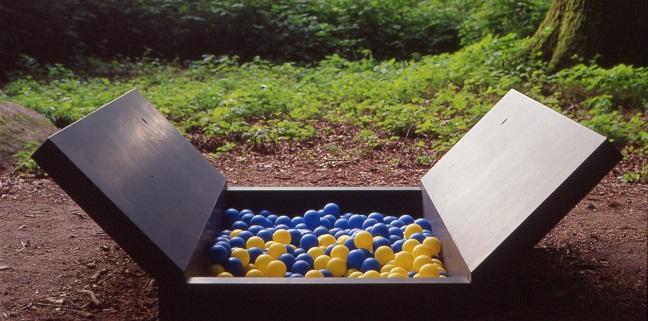
Mirosław Bałka
(Född/Born 1958, verksam i Warszawa/works in Warsaw)
Play-pit, 2000
Diabas, plast/Diabase, plastic
206 x 150 x 60 cm
Med stöd från/With support from Broby Granit
For English please scroll down
Undangömt i en glänta ligger Mirosław Bałkas Play-pit. Till skillnad från de flesta andra konstnärerna på Wanås har han arbetat sig ner i marken. En kistliknande form av svart diabas är nedsänkt i jorden. Längs sidorna är svarta stenskivor uppfällda som ett öppet lock. Konstnären utgår från sin egen kropp – hans längd och bredd återspeglas i kistans proportioner. Bollarna som fyller kistan är blå och gula som svenska flaggans klara färger och lockar till att stiga ner i verket. Kistan och bollarna står i skarp kontrast till varandra, och anspelar på allvar och lek, beständighet och förgänglighet.
Samma motsatsförhållande fanns i verket Sch, som Balka visade parallellt med Play-pit i utställningen WANÅS 2000. Likt svartvita festdeokarationer hängde han långa girlanger av hopvikta och sammanklistrade dödsrunor från dagstidningar och lät dem löpa genom flera rum i Magasinets bottenvåning.
Bałkas konstnärskap präglas av motsatser. Han använder djupt personliga referenser – sin kropp, uppfostran och sina egna tillhörigheter likaväl som kollektiva erfarenheter från förintelsen, polsk historia eller katolska ceremonier. Han förenar intimitet med det monumentala. Referenser till död och förlust är ständigt återkommande i hans konstnärskap. Bałka fick uppdraget att utforma minnesvården över dem som omkom när färjan Estonia förliste i Östersjön 1994. Estoniaminnesvården uppfördes 1997 och står idag vid Galärvarvskyrkogården på Djurgården i Stockholm.
>>>
Tucked away in a glade lies Mirosław Bałka’s Play-pit. Unlike most other artists represented at Wanås, he has worked himself down into the ground. A coffin-like form made of black diabase is sunken into the earth. Along the sides, black slabs of stone angle out like an open lid. The artist uses his own body as a starting point—his height and width are reflected in the proportions of the coffin. The balls filling the coffin are blue and yellow, the bright hues of the Swedish flag, and tempt the viewer to step down into the work. The coffin and the balls stand in stark contrast to each other, and they play on the sombre and the playful, on permanence and transience.
The same contrast is found in the artwork Sch, which Bałka displayed parallel to Play-pit in the exhibition WANÅS 2000. He hung long garlands of newspaper obituaries, folded up and pasted together like black-and-white party decorations, stringing them trough several rooms on the ground flopr of the Barn.
Bałka’s oeuvre is characterized by contrasts. He uses deeply personal reference points—his body, his upbringing, and his own belongings—as well as collective experiences from the Holocaust, Polish history, or Catholic ceremonies. He unites the intimate with the monumental. References to death and loss recur constantly in his art. Bałka was commissioned to design the memorial for the victims of the M/S Estonia Disaster in the Baltic Sea in 1994, in which the passenger ferry sank due to hull leakage, and many lost their lives. The Estonia Monument was erected in 1997 and today stands in the cemetery Galärvarvet on Djurgården in Stockholm.